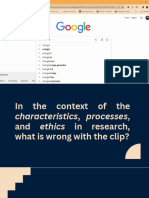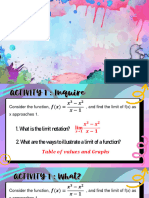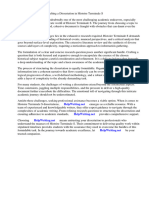0 ratings0% found this document useful (0 votes)
17 viewsSelecting and Organizing Information
Selecting and Organizing Information
Uploaded by
Clarenz Ken TatierraThe document discusses different methods for organizing information, including brainstorming, which helps establish patterns of ideas, and graphic organizers like fishbone maps, Venn diagrams, problem-solution maps, cycles, plot diagrams, timelines, network trees, and spider maps. These graphic organizers use visual representations like circles, diagrams, and trees to structure concepts and connect related information in areas like comparing ideas, showing causes and effects, mapping stories, and representing hierarchies. The document also includes an activity identifying which graphic organizer matches different descriptions.
Copyright:
© All Rights Reserved
Available Formats
Download as PPTX, PDF, TXT or read online from Scribd
Selecting and Organizing Information
Selecting and Organizing Information
Uploaded by
Clarenz Ken Tatierra0 ratings0% found this document useful (0 votes)
17 views14 pagesThe document discusses different methods for organizing information, including brainstorming, which helps establish patterns of ideas, and graphic organizers like fishbone maps, Venn diagrams, problem-solution maps, cycles, plot diagrams, timelines, network trees, and spider maps. These graphic organizers use visual representations like circles, diagrams, and trees to structure concepts and connect related information in areas like comparing ideas, showing causes and effects, mapping stories, and representing hierarchies. The document also includes an activity identifying which graphic organizer matches different descriptions.
Original Title
Selecting-and-Organizing-Information
Copyright
© © All Rights Reserved
Available Formats
PPTX, PDF, TXT or read online from Scribd
Share this document
Did you find this document useful?
Is this content inappropriate?
The document discusses different methods for organizing information, including brainstorming, which helps establish patterns of ideas, and graphic organizers like fishbone maps, Venn diagrams, problem-solution maps, cycles, plot diagrams, timelines, network trees, and spider maps. These graphic organizers use visual representations like circles, diagrams, and trees to structure concepts and connect related information in areas like comparing ideas, showing causes and effects, mapping stories, and representing hierarchies. The document also includes an activity identifying which graphic organizer matches different descriptions.
Copyright:
© All Rights Reserved
Available Formats
Download as PPTX, PDF, TXT or read online from Scribd
Download as pptx, pdf, or txt
0 ratings0% found this document useful (0 votes)
17 views14 pagesSelecting and Organizing Information
Selecting and Organizing Information
Uploaded by
Clarenz Ken TatierraThe document discusses different methods for organizing information, including brainstorming, which helps establish patterns of ideas, and graphic organizers like fishbone maps, Venn diagrams, problem-solution maps, cycles, plot diagrams, timelines, network trees, and spider maps. These graphic organizers use visual representations like circles, diagrams, and trees to structure concepts and connect related information in areas like comparing ideas, showing causes and effects, mapping stories, and representing hierarchies. The document also includes an activity identifying which graphic organizer matches different descriptions.
Copyright:
© All Rights Reserved
Available Formats
Download as PPTX, PDF, TXT or read online from Scribd
Download as pptx, pdf, or txt
You are on page 1of 14
Selecting and Organizing Information
GUESS THE PICTURE
Patrick’s class was tasked with the opening
presentation during their school’s Foundation Day. The
school has already decided on a theme, and the class was
simply required to decide its own concept for the
performance. Although Patrick facilitated the discussion,
all of his classmates were involved because they all shared
their own ideas. After everyone has contributed an idea,
they evaluated the suggestions and decided to use
Gabriel’s idea to do a musical skit.
What is Brainstorming?
It helps people establish patterns of ideas,
develop new ways of thinking, activate
background knowledge, and overcome mental
block.
What are Graphic Organizers?
Are visual representations of concepts that help
us structure information into organizational
patterns. They present essential information and
connect these pieces of information into a
coherent framework
Fishbone Map is used to better
understand the causal relationship of
a complex phenomenon. It shows
the factors that cause a specific
event or problem, as well as details
of each cause.
Venn Diagram is used to
compare and contrast ideas
and events. This diagram uses
two or more overlapping circles
to show similar and different
attributes.
Problem-Solution Map displays
the nature of the problem and
how it can be solved. This map
usually contains the problem’s
description, its causes and effects,
and logical solutions.
Cycle describes how a series of
events interact to produce a set of
results repeatedly.
Plot Diagram is a tool used to map
events in a story. It is used to
analyze the major parts of a plot.
Timeline is used to show how
events occurred chronologically
through a long bar labeled with
dates and specific events.
Network Tree is used to represent
hierarchy, classification, and
branching. It is useful in showing
relationships of scientific
categories and family trees.
Spider Map is used to investigate
and enumerate various aspects of
a central idea, which could be a
concept, topic, or theme. This
central idea is placed at the center
of the map.
Activity no. 1
Identify what is being asked.
1. Used to show causes and effects
2. Used to show repeated results
3. Used to show the flow of the story
4. Used to show similarities and differences
5. Used to enumerate items
6. Used to represent hierarchy, classification, and branching
7. Are visual representations of concepts
8. Displays the nature of the problem and how it can be solved
9. Helps establish patterns of ideas
10.Used to show how events occurred chronologically
You might also like
- STARBUCKS' Line Up Strategy: by Eirini Tougli Penny Vlagos Global Strategies New York CollegeDocument22 pagesSTARBUCKS' Line Up Strategy: by Eirini Tougli Penny Vlagos Global Strategies New York CollegeEirini Tougli75% (4)
- Selecting and Organizing InformationDocument33 pagesSelecting and Organizing InformationDemi BarrancoNo ratings yet
- RW Selecting & Organizing InformationDocument25 pagesRW Selecting & Organizing Informationgl.pertacorta1226No ratings yet
- Graphic OrganizersDocument4 pagesGraphic OrganizersYukiNo ratings yet
- Selecting and Organizing InformationDocument22 pagesSelecting and Organizing InformationMaria TakahashiNo ratings yet
- Selecting and Organizing Information (Brainstorming)Document12 pagesSelecting and Organizing Information (Brainstorming)Vincent A. Sunggayan-NiezNo ratings yet
- Graphic OrganizersDocument45 pagesGraphic OrganizersRanjeeta SahooNo ratings yet
- Week 11-12 - Unit 3-Topic 2Document17 pagesWeek 11-12 - Unit 3-Topic 2beautyhz2996No ratings yet
- IM - Reading Strategies, Techniques in Selecting and Organizing Information, & Patterns of CommunicationDocument9 pagesIM - Reading Strategies, Techniques in Selecting and Organizing Information, & Patterns of Communicationcmibarreta8478No ratings yet
- Textual Aids FinalDocument66 pagesTextual Aids FinalElaisa RosalesNo ratings yet
- 2e Fely's Graphic OrganizersDocument40 pages2e Fely's Graphic OrganizersClydylyn PastorNo ratings yet
- Graphic Organizers As Thinking TechnologyDocument32 pagesGraphic Organizers As Thinking TechnologyGab Ilagan100% (1)
- Reviewer in English 10Document9 pagesReviewer in English 10Martin JohnNo ratings yet
- My Graphic OrganizerDocument7 pagesMy Graphic OrganizerNoveline AcostaNo ratings yet
- Reading and Writing 2Document44 pagesReading and Writing 2meliasuzzielNo ratings yet
- Multicultural EducationDocument7 pagesMulticultural EducationJealyn AstillarNo ratings yet
- Writing Using Graphic OrganizersDocument13 pagesWriting Using Graphic OrganizersLucio Dc ParcutelaNo ratings yet
- Reading and Writing Skills 1.1.2Document5 pagesReading and Writing Skills 1.1.2Yasien PangcogaNo ratings yet
- SHS Academic Reading and Writing Week 3Document14 pagesSHS Academic Reading and Writing Week 3Sir Ryan ZNo ratings yet
- SC - Techniques in Selecting and Organizing InformationDocument55 pagesSC - Techniques in Selecting and Organizing InformationVA Sayven AbaoNo ratings yet
- Graphic OrganizersDocument11 pagesGraphic OrganizersMoriartyNo ratings yet
- Lesson6. TTL-Graphic OrganizerDocument8 pagesLesson6. TTL-Graphic OrganizerKIMBERLY AVISONo ratings yet
- Graphic Organizer PDFDocument24 pagesGraphic Organizer PDFAnnie AbejoNo ratings yet
- G10 Q1 Module 2Document13 pagesG10 Q1 Module 2carolinobabelynNo ratings yet
- Graphic OrganizersDocument16 pagesGraphic OrganizersMutya Kismet LogroñoNo ratings yet
- Determining Textual AidsDocument36 pagesDetermining Textual AidsNicka NipalesNo ratings yet
- Graphic OrganisersDocument43 pagesGraphic OrganisersJince JosephNo ratings yet
- Understanding of A Text (En10Rcla-2.15.2)Document8 pagesUnderstanding of A Text (En10Rcla-2.15.2)zenaidaydelacruzNo ratings yet
- Synapse Strengtheners: AnswerDocument5 pagesSynapse Strengtheners: AnswerAurea Jasmine Dacuycuy100% (4)
- Graphic OrganizersDocument13 pagesGraphic OrganizersJulian Lennon Dabu100% (1)
- Textual AidDocument29 pagesTextual Aidmelomira2288No ratings yet
- Different Textual Aids To Help You Understand What You ReadDocument7 pagesDifferent Textual Aids To Help You Understand What You ReadgumalerichNo ratings yet
- Techniques in Selecting and Organizing InformationDocument4 pagesTechniques in Selecting and Organizing InformationFaith Seminiano098No ratings yet
- Graphic Organizer LessonDocument22 pagesGraphic Organizer Lessonanon_444346452No ratings yet
- Graphic OrganizersDocument16 pagesGraphic OrganizersAriane del RosarioNo ratings yet
- GraphicDocument9 pagesGraphicCristine joy OligoNo ratings yet
- Title Description: 3-2-1 ReflectionDocument1 pageTitle Description: 3-2-1 ReflectionpadmaNo ratings yet
- English10 Q1 Module 2Document7 pagesEnglish10 Q1 Module 2Azalea SmithNo ratings yet
- RW Day8Document31 pagesRW Day8John Perry PolicarpioNo ratings yet
- Using Graphic OrganizerDocument15 pagesUsing Graphic OrganizerElla ReverenteNo ratings yet
- Textual AidsDocument19 pagesTextual Aidserwin rectoNo ratings yet
- RWS 2.1 Graphic Organizer22 (AutoRecovered)Document11 pagesRWS 2.1 Graphic Organizer22 (AutoRecovered)Margie Tirado JavierNo ratings yet
- Thinking ToolsDocument2 pagesThinking Toolsm-859867No ratings yet
- Graphic OrganizersDocument2 pagesGraphic OrganizersmissnancyrcNo ratings yet
- Lesson 3 Selecting and Organizing InformationDocument39 pagesLesson 3 Selecting and Organizing InformationWilma S. MabagNo ratings yet
- Techniques in Selecting and Organizing InformationDocument35 pagesTechniques in Selecting and Organizing Informationsammy elisanNo ratings yet
- Textual AidsDocument21 pagesTextual AidsKristal Mae BulanteNo ratings yet
- Graphic Organizers As Thinking TechnologyDocument26 pagesGraphic Organizers As Thinking Technologyᜄᜓᜄᜓᜇᜀᜈᜄ ᜎᜒᜐᜓᜄᜀ67% (3)
- 1.elisaherrerapatiño - Enseñanza Del Vocabulario - Julio 21.2020 PDFDocument4 pages1.elisaherrerapatiño - Enseñanza Del Vocabulario - Julio 21.2020 PDFDiana MarisolNo ratings yet
- Many Graphic OrganiserDocument8 pagesMany Graphic OrganiserMay'n SnNo ratings yet
- Textual AidsDocument13 pagesTextual AidsNoella LuarezNo ratings yet
- Lesson 2 - Techniques in Selecting and Organizing InformationDocument58 pagesLesson 2 - Techniques in Selecting and Organizing InformationalexraphaelnagtalonNo ratings yet
- Graphic Organizer WK 3Document39 pagesGraphic Organizer WK 3Rina TuberaNo ratings yet
- Graphic Organizers - Dr. Pedro A. Rasse M.Document4 pagesGraphic Organizers - Dr. Pedro A. Rasse M.AntuanNo ratings yet
- Graphic OrganizerDocument5 pagesGraphic OrganizerA CNo ratings yet
- Lesson 1 Brainstorming and Graphic OrganizerDocument48 pagesLesson 1 Brainstorming and Graphic Organizersumalinogwawayss1No ratings yet
- English 10 (Worksheet Week 5 Lesson 5 Effects of Textual Aids) - LeodonesDocument1 pageEnglish 10 (Worksheet Week 5 Lesson 5 Effects of Textual Aids) - LeodonesReynalyn LeodonesNo ratings yet
- SubjectDocument1 pageSubjectKrenzy Breeza Mante BisayaNo ratings yet
- Information Organization Methods: Jesús GutiérrezDocument25 pagesInformation Organization Methods: Jesús GutiérrezJaime SaenzNo ratings yet
- Big Ideas for Growing Mathematicians: Exploring Elementary Math with 20 Ready-to-Go ActivitiesFrom EverandBig Ideas for Growing Mathematicians: Exploring Elementary Math with 20 Ready-to-Go ActivitiesRating: 4.5 out of 5 stars4.5/5 (3)
- Coupled ReactionDocument34 pagesCoupled ReactionClarenz Ken TatierraNo ratings yet
- Fourth Quarter Activity 3Document2 pagesFourth Quarter Activity 3Clarenz Ken TatierraNo ratings yet
- EnzymesDocument29 pagesEnzymesClarenz Ken TatierraNo ratings yet
- Lesson 2 PR1Document25 pagesLesson 2 PR1Clarenz Ken TatierraNo ratings yet
- 3 Limit LawsDocument21 pages3 Limit LawsClarenz Ken TatierraNo ratings yet
- Strategies To Avoid Communication BreakdownDocument2 pagesStrategies To Avoid Communication BreakdownClarenz Ken TatierraNo ratings yet
- 2 Distinguish Limit of A Function From Evaluating A FunctionDocument24 pages2 Distinguish Limit of A Function From Evaluating A FunctionClarenz Ken TatierraNo ratings yet
- Construction Field 2.0Document25 pagesConstruction Field 2.0Clarenz Ken TatierraNo ratings yet
- Nature Functions and Elements of CommunicationDocument14 pagesNature Functions and Elements of CommunicationClarenz Ken TatierraNo ratings yet
- Communication BreakdownDocument10 pagesCommunication BreakdownClarenz Ken TatierraNo ratings yet
- Inbound 7598504691596617368Document25 pagesInbound 7598504691596617368Clarenz Ken TatierraNo ratings yet
- Sufism and Bhakti Shaping A Composite Culture in IndiaDocument5 pagesSufism and Bhakti Shaping A Composite Culture in Indiavihaan.desai1220No ratings yet
- APUSH Period 7 VocabularyDocument1 pageAPUSH Period 7 Vocabularybillle1207301No ratings yet
- Design of ExperimentDocument25 pagesDesign of Experimentkushal NeupaneNo ratings yet
- Lineage in Siam by King Chulalongkorn (Data Paper: Number 81, Southeast, AsiaDocument15 pagesLineage in Siam by King Chulalongkorn (Data Paper: Number 81, Southeast, AsiasfsrteyddfgNo ratings yet
- Placement TestDocument11 pagesPlacement Testanitha nathenNo ratings yet
- Maurice A. Olivares: Department of EducationDocument38 pagesMaurice A. Olivares: Department of EducationMaurice OlivaresNo ratings yet
- Expense StudyDocument21 pagesExpense StudyIotalaseria PutuNo ratings yet
- Dissertation Histoire Terminale SDocument4 pagesDissertation Histoire Terminale SPayPeopleToWritePapersSingapore100% (1)
- The Truth Behind StarbucksDocument6 pagesThe Truth Behind Starbuckswileyge01280% (5)
- Cp154 Illegal Transactions ConsultationDocument188 pagesCp154 Illegal Transactions ConsultationjmalemanyNo ratings yet
- Side Effects of Common Drugs PDFDocument2 pagesSide Effects of Common Drugs PDFImran ChaudhryNo ratings yet
- Fundamental 1Document2 pagesFundamental 1Neeraj BhauryalNo ratings yet
- 5 BocoetalDocument20 pages5 BocoetalLoriebeth RodriguezNo ratings yet
- Reflection Paper For SupervisionDocument5 pagesReflection Paper For SupervisionSanhoihpa Khaineu100% (2)
- Criminology Project PDFDocument12 pagesCriminology Project PDFMohammad Ziya AnsariNo ratings yet
- VED 101 Module 2 PDF StyleDocument92 pagesVED 101 Module 2 PDF StyleKim ArdaisNo ratings yet
- Introduction To BS9999 - 2008 - Maurice JohnsonDocument54 pagesIntroduction To BS9999 - 2008 - Maurice JohnsonAhmet_Cullu_681100% (3)
- Homogeneous Nucleation NotesDocument4 pagesHomogeneous Nucleation NotesLiam ClinkNo ratings yet
- Chapter 3 Nuclear RadiationDocument164 pagesChapter 3 Nuclear RadiationJoseph MabajenNo ratings yet
- 2008-Smith & Wittmann - Applying A Resources Framework To Analysis of The Force and Motion Conceptual EvaluationDocument19 pages2008-Smith & Wittmann - Applying A Resources Framework To Analysis of The Force and Motion Conceptual EvaluationRISKI DAMAYNo ratings yet
- Thrust Bearings: 53210 29430 E U210 M 81110 TN P5Document20 pagesThrust Bearings: 53210 29430 E U210 M 81110 TN P5Ismael RiosNo ratings yet
- Cramers Rule 3 by 3 Notes PDFDocument4 pagesCramers Rule 3 by 3 Notes PDFMehwish HussainNo ratings yet
- The People of The Philippines, Plaintiff-Appellee, vs. Freedie Lizada at Fredie LIZADA, Accused-AppellantDocument18 pagesThe People of The Philippines, Plaintiff-Appellee, vs. Freedie Lizada at Fredie LIZADA, Accused-AppellantFredamoraNo ratings yet
- Student Blog 2012Document32 pagesStudent Blog 2012Haris HabibNo ratings yet
- Ian Raeside, Early Prose Fiction in MarathiDocument19 pagesIan Raeside, Early Prose Fiction in Marathiprarochana100% (1)
- Tai Sophia Institute Master of Science in Nutrition and Integrative HealthDocument4 pagesTai Sophia Institute Master of Science in Nutrition and Integrative Healthapi-96990759No ratings yet
- Qualifications: Key ResponsibilitiesDocument6 pagesQualifications: Key ResponsibilitiesArbabNo ratings yet
- Free FallDocument24 pagesFree FallNoob KidNo ratings yet



































































































